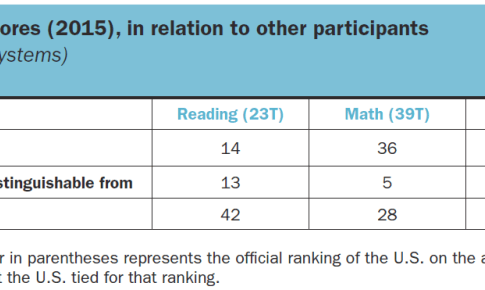It’s late October, which means the Fall Classic is upon us. The baseball playoffs and their culmination in the World Series naturally emphasize competition and the ranking of teams across the major leagues. There is no confusion about how the Boston Red Sox and the St. Louis Cardinals are ranked. Juxtapose this with the recent spate of media stories about how our education system compares to other countries in the world. And here there is almost complete confusion about the rankings. Which is a shame, because the stakes are much higher than the World Series. Indeed, our economic prosperity and competitiveness hinges on how well we educate children.
Last week a new study released by the U.S. Education Department, called the Trends in Mathematics and Science Study (TIMSS), had some dismal results for American students, despite spin to the contrary. All U.S. states participated in the study, which was designed to link performance of U.S. students to that in other countries. The comparisons in the study also shows there are huge performance gaps among states. Mississippi, Alabama and District of Columbia students scored below on the international average on both exams, meaning their scores were on par with Kazakhstan and Dubai.
The headline in the New York Times was “Eighth-graders in 36 states performed above the mathematics and science averages.”
That sounds pretty good until one goes into the details and finds out what league is being assessed. Only a third of the OECD countries — the club of most developed nations of the world — participated in TIMSS. TIMSS, for example, did not include Singapore, Switzerland, Netherlands, Germany, or Poland. Instead, the TIMSS countries were heavily weighted toward developing nations — Armenia, Ghana, Oman, Syria….
No headline about the World Series makes the point that the league finalists — the Detroit Tigers and the Los Angeles Dodgers — could beat most of the baseball teams in the AA leagues even if not at the top of the majors. But that is exactly what the rankings on the TIMSS test are telling us.
There are actually two different international assessments for mathematics and science. The other assessment, the Programme for International Student Assessment or PISA, includes all of the OECD countries. On the PISA assessment for 2009, 31 nations were ahead of us in math, but only 12 of those that led us in PISA also participated in TIMSS.
It is not just a matter of pride or of publicity. Playing in the first division in terms of student achievement carries over to what our workforce will look like in the future. And our economic well-being is directly dependent on the quality of our workforce.
In a recent book with our colleague Ludger Woessmann from Munich, we consider the economic implications of playing in the wrong league. By our estimates based on historic relationships, if the U.S. could rise to the level of Canada over the next twenty years, the average U.S. worker could have a 20 percent larger paycheck every year for the next 80 years.
Our book, Endangering Prosperity, shows how the U.S. states compare to the first division countries in economic competition. While the TIMSS comparison speaks of 36 states being above the test average, the PISA tests show that our thirty-sixth state falls between Latvia and Lithuania. This is hardly the comparison group that we should be happy with.
Instead of being complacent about our international standings, we should focus on ways to get our students up to the top leagues. There is considerable disagreement about the precise way to do this, but there is also broad recognition of key factors.
Every current study of student performance today points to the importance of highly effective teachers and leaders. Strong teachers, by our calculations, can lead us to the top of the world rankings — and gain us the commensurate economic performance. Moreover, this is not a matter a completely replacing our current teachers. The vast majority of current teachers are ones we should keep. They will participate in the renovation of our schools.
At the same time, we want to ensure that our best teachers stay in the classroom longer. This implies rewarding them for their performance so that they are not tempted to leave the schools. We also want to ensure that our least effective teachers move out of the classroom to places where they are better suited.
The research evidence shows clearly that some combination of strong accountability for student outcomes, of performance pay for teachers and administrators, of expanded school choice, and of local autonomy and decision making would be helpful in getting to this better outcome. Getting there requires parental involvement. It requires strong policy interventions. And most of all it requires the leadership of those currently in the schools.
Eric Hanushek is a senior fellow at the Hoover Institution of Stanford University. Paul Peterson is a professor of government at Harvard University.
This first appeared on Huffington Post.




